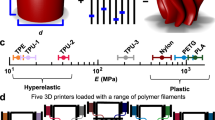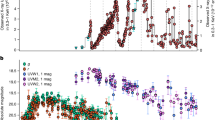Abstract
THE bearing of Rayleigh's law of gaseous extinction on some of the fundamental aspects of radiation theory does not seem to have been sufficiently emphasised in recent reports and publications on modern molecular physics. The coefficient of attenuation κ of radiation of wave-length λ travelling through a gas containing n0 molecules per unit volume was given by Rayleigh1 so long ago as 1871 in the form κ=84, π 3(µ20 – I)2λ−4/n0, µ0 being the refractive index of the gas. It is of importance to notice that the law in question is one of the most fundamental results of molecular dynamics, its final expression being an invariant with respect to the theories of the æther or of the molecule employed2, while in its derivation there is no need to draw on resources outside classical dynamics and continuous energy-flow. From the point of view of elementary electromagnetic theory, the above expression κ for is very easily derived along lines suggested in a problem set in part ii. of the “Mathematical Tripos”3; use is made of the conventional electrical doublet set into forced vibrations by a train of electromagnetic waves; by making use of the radiation formula for accelerated charges and Poynting's theorem, the flow of energy from the doublet is easily calculated in terms of the amplitude of vibration; the oscillations of the doublet contribute a term to Maxwell's displacement current, enabling the amplitude to be expressed in terms of the refractive index of the gas; by considering the depletion of energy from the original beam as a result of this scattering, and eliminating the amplitude, the above expression for κ is easily obtained. In a recent paper, Natanson4 has subjected the derivation of Rayleigh's law to minute criticism on the grounds of the classical electromagnetic theory, allowing for a damping term arising from the mechanical reaction due to radiation, and taking into special consideration the summation of the aggregate radiation from the random distribution of doublets which are supposed to constitute the molecules of the gas; the final result is a vindication of the above expression for the coefficient of attenuation to a very high order of accuracy. It may be noticed in passing that the same electromagnetic system forms the basis of Planck's5 theory of black-body radiation, the interpretation of experiment in this case, however, necessitating the hypothesis of discontinuous energy-flow, or the emission of energy by quanta.
This is a preview of subscription content, access via your institution
Access options
Subscribe to this journal
Receive 51 print issues and online access
$199.00 per year
only $3.90 per issue
Buy this article
- Purchase on Springer Link
- Instant access to full article PDF
Prices may be subject to local taxes which are calculated during checkout
Similar content being viewed by others
References
Rayleigh, Phil. Mag., xli., pp. 107, 274, 447 (1871); Collected Works, i., pp. 87, 104, 518.
Schuster, Theory of Optics, 2nd ed. (1909), p. 325.
Mathematical Tripos, Part ii., June 2, 1906.
Natanson, Bull. Inter. de l'Acad mie des Sciences de Cracovie January 5, 1914.
Planck, Theory of Heat Radiation (Trans, by Masius, Blakiston's, Philadelphia, 1914). part iv., chap. iii. p 165.
Annals of the Smithsonian Astrophysical Observatory. Washington: vol. ii. (1908); vol. iii. (1913).
Schuster, NATURE, July 22, 1909: Optics, 2nd ed., 1909, p. 379.
Natanson, Bull. Inter. de l'Acad mie des Sciences de Cracovie, December 13, 1909.
King, Phil. Trans. Roy. Soc., 212 A, p. 392, 1912.
E. Rutherford and H. Geiger, Roy. Soc. Proc., A, vol. lxxxi., 190 P. 171.
Planck, loc. cit., p. 172.
Millikan, Phys. Rev., ii., ser. 2, pp. 109 143, August, 1913: Phys. Zeitschrift, xiv., pp. 796 812, September 1, 1913.
Fowle, Astrophysical Journal, xxxviii., No. 4, p. 398, November, 1913.
King, loc. cit., p. 394.
Debye, Ann. der Phys., iv., 39, p. 789. (1912.)
Born and K rm n, Phys. Zeitschr., xiv., p. 15; also p. 65. (1913.)
Author information
Authors and Affiliations
Rights and permissions
About this article
Cite this article
KING, L. Rayleigh's Law of Extinction and the Quantum Hypothesis. Nature 93, 557–559 (1914). https://doi.org/10.1038/093557c0
Issue Date:
DOI: https://doi.org/10.1038/093557c0
Comments
By submitting a comment you agree to abide by our Terms and Community Guidelines. If you find something abusive or that does not comply with our terms or guidelines please flag it as inappropriate.



